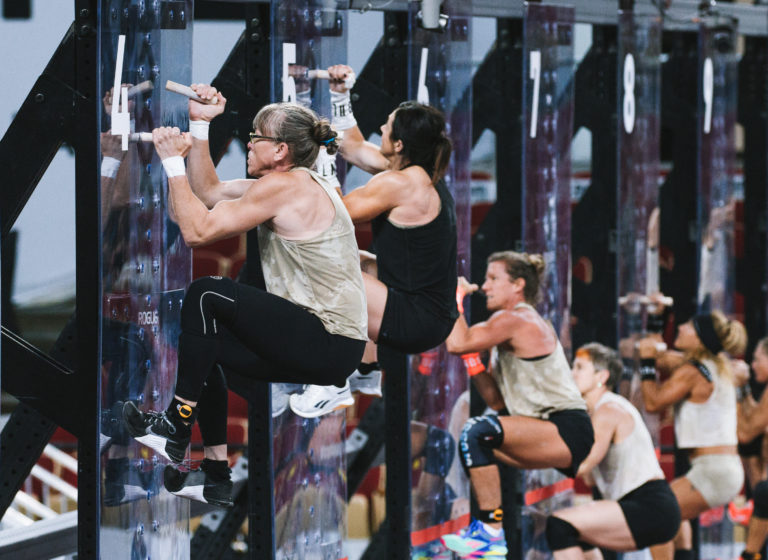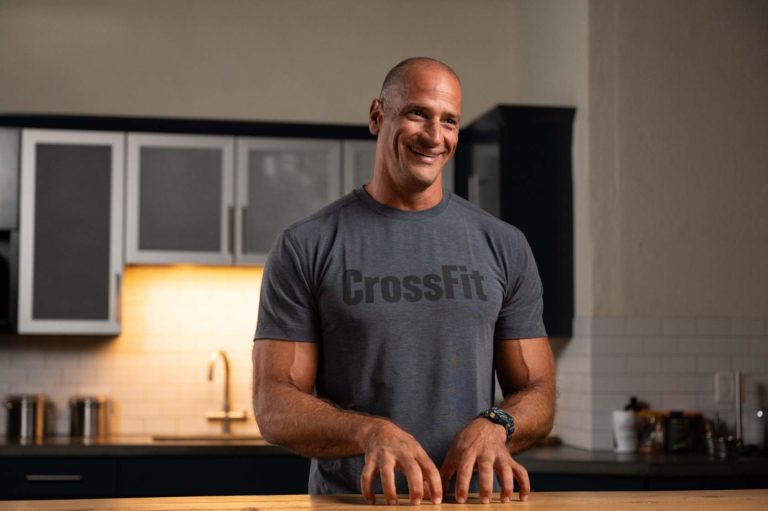Research into the effects of aging often leads to misconceptions about aging and fitness for older athletes. However, CrossFit’s Coaching the Aging Athlete course is a valuable resource that debunks these myths, providing a more realistic and optimistic view of training as an older athlete.
Myth #1: Older Athletes Cannot Get Stronger or Improve Their Physical Capacity
A lot of research on the effects of aging investigates sedentary populations. Naturally, that research concludes that strength and muscle mass decline with age. Of course it does. If you don’t use it, you lose it. However, many unfortunately make the leap from there that older athletes cannot get stronger or improve their fitness as they age. This, of course, is not true. Countless numbers of older athletes training at CrossFit affiliates have proven that aging athletes can not only maintain strength and fitness levels as they age but also get stronger and fitter as they age if training is maintained. In fact, aging athletes can continue to adapt to exercise stimuli similarly to younger adults. Strength and muscle mass do not decline due to aging alone but rather due to aging and inactivity.
The masters divisions of the CrossFit Games also provide compelling empirical data that strength and physical capacity can improve with training even as an athlete grows older. As we follow their competitive careers, we’ve seen tremendous improvements in athletes who have competed in multiple age categories. Increases in strength of 10% as athletes move up age categories are not uncommon. The message is clear: not only can older athletes improve their capacity, they can improve it significantly.
Myth #2: Older Athletes Should Not Train at Intensity
 Older adults are often told to avoid strenuous activity. The misconception they should not train with intensity is based on the misguided belief that intensity places the athlete at greater risk of injury.
Older adults are often told to avoid strenuous activity. The misconception they should not train with intensity is based on the misguided belief that intensity places the athlete at greater risk of injury.
Intensity is a critical component of CrossFit, leading to results regardless of age. In CrossFit, we tailor the intensity to the individual’s physical and psychological tolerances, ensuring it is safely individualized to the athlete’s current capacity. This approach, combined with the charter of teaching correct mechanics first, achieving consistency second, and only then applying relative intensity. Every minimizes the risk of injury and maximizes the benefits of training with intensity for older athletes.
Injury rates for older athletes correlate more with overuse than intensity, and injury rates in trained older athletes are low and do not increase with age. Intensity plays an essential role in reducing injury risk because of the associated reduction in volume, while extremes of endurance exercise and prolonged (or chronic) training increase the risk of injury. When appropriately prescribed, regular training with intensity is most appropriate for older athletes as it supports better bone density and lean muscle mass, and potentially minimizes the decline in anaerobic work capacity as we age.
Myth #3: Older Athletes Should Avoid Complex Gymnastics and Weightlifting
Doctors regularly counsel older athletes that all they need for exercise is walking, swimming, or biking. Although these activities may be a good starting point for someone who has lived life on the couch, it is a myth that older adults need a simplified exercise program. For transformative fitness and health results, the older athlete must incorporate strength and power training and the neurological components of fitness: coordination, accuracy, agility, and balance.
CrossFit is unique in its ability to train all these qualities by incorporating complex motor patterns in the form of gymnastics and Olympic weightlifting. While gymnastics and weightlifting movements are excellent for developing strength and power, they may be even more impressive at training neurological skills. The benefits of neurological capacity cannot be overstated, and the requirement to train these components only increases with age. Older athletes, particularly those 55 and older, find neurological skills more challenging to learn, which exactly describes their need to include them in their program. With appropriate scaling, everybody can learn gymnastics movements and the Olympic lifts at appropriate loads. The struggle to master these movements is the essential work that must be done to hone neurological components. This is why older athletes should have access to a full-fledged CrossFit program instead of a reduced or segmented version. For all ages, CrossFit can be appropriately scaled. Any limitation in teaching an aging athlete complex movements lies in the trainer’s skill, not in the client’s capacity.
Myth #4: Older Athletes Can’t Train Hard Because They Have Diminished Ability to Recover
It is a common assumption among coaches and athletes that it is harder to recover as you get older; therefore, older athletes need less work and more recovery time. By recovery, we simply mean being ready to go again without impaired performance. The truth is aging athletes can work hard, but to do so and recover, they need to do everything right regarding recovery strategies. A younger athlete can possibly tolerate a poor lifestyle and still recover, but an older athlete cannot. This suggests lifestyle factors contribute more to poor recovery than age alone. It doesn’t help that lifestyle factors that negatively impact recovery, such as limited training time, work demands, poor sleep, stress, inadequate nutrition, social commitments, and alcohol, are probably more prominent in the aging population. For many older athletes, their physiology can handle much more than their chosen lifestyle allows.
So, while it is convenient for aging athletes to blame poor recovery on their age, they must first ensure they are doing what they need to do to maximize recovery: sleeping, getting proper nutrition, de-stressing, practicing active recovery techniques, etc. If an athlete is doing everything right but still failing to recover, it’s likely the training volume has not been appropriately scaled. In this situation, reps, sets, and rounds should be adjusted, and an extra rest day per week should be added until recovery improves. This will reduce overall volume. Once the athlete is thriving again, the training day can be added back in.
Don’t Believe The Hype
We have always believed in the applicability of a regimen like CrossFit for older and deconditioned or detrained populations. The needs of an Olympic athlete and our grandparents differ by degree, not kind. One is looking for functional dominance, and the other is looking for functional competence. We scale load and intensity; we don’t change programs.
To fight the effects of aging, older athletes must improve their strength and overall capacity by training regularly and with an appropriate amount of intensity in all the functional movements available to them. Effective training becomes critical for staving off disease and decrepitude as we age. The myths propagated by the media and some medical professionals about how older athletes should train do nothing but add confusion and fear into the equation. If you know an older athlete who is hesitant to start training or doesn’t know what they should be doing, please share this discussion with them so these pervasive myths don’t dissuade them from seeking a strength and conditioning program that will radically transform their fitness and quality of life.
About the Author
 Stephane Rochet is a Senior Content Writer for CrossFit. He has worked as a Flowmaster on the CrossFit Seminar Staff and has over 15 years of experience as a collegiate/tactical strength and conditioning coach. He is a Certified CrossFit Trainer (CF-L3) and enjoys training athletes in his garage gym.
Stephane Rochet is a Senior Content Writer for CrossFit. He has worked as a Flowmaster on the CrossFit Seminar Staff and has over 15 years of experience as a collegiate/tactical strength and conditioning coach. He is a Certified CrossFit Trainer (CF-L3) and enjoys training athletes in his garage gym.
Myths About Aging